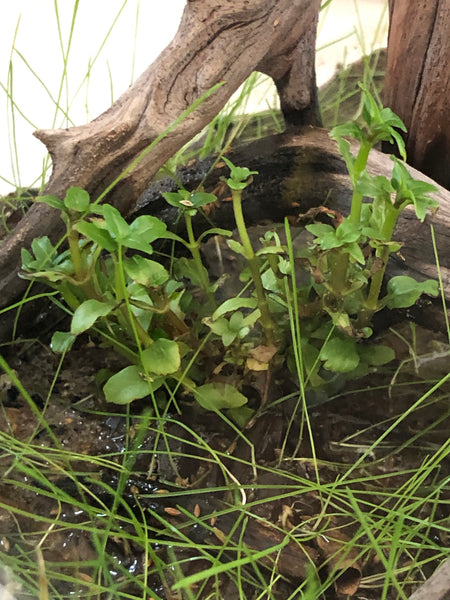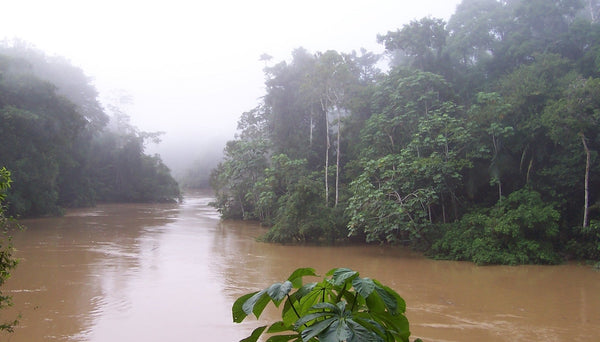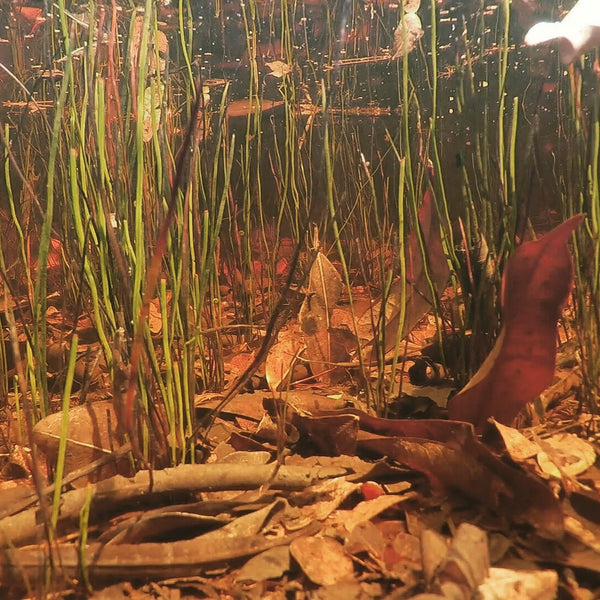- Continue Shopping
- Your Cart is Empty
During the dry season
It's always interesting to look at new ideas in this hobby...or even not-so-new ideas from a slightly different angle, isn't it?
We have written and discussed the flooded forests of South America many times here in "The Tint", and they are among the most compelling habitats we have encountered during our search for interesting ones to replicate in aquariums.
South American forests and "swamp forests"are seasonally inundated with freshwater. These forests are perhaps Nature's finest example of the interaction between land and water, and how diverse and surprisingly productive aquatic environments arise in these habitats.
The two types of inundated forest areas are blackwater systems known as igapó, and the counterpart "whitewater" systems called várzea.
The igapó is characterized by seasonal inundation caused by a large amount of rainfall, and thus, in some areas, trees can be submerged for up to 6 months of the year. We've touched on the idea of replicating this habitat in "The Tint" some time ago. These forests have sandy, rather acidic soils with a very low nutrient content. The rainwater combines with the humic substances and tannins contained in the soils and the forest floor materials that are found on them.
The acidity from the water corresponds to the acidic soils of these forests. They are the more nutrient poor than a comparable várzea forest, carrying less inorganic elements, yet higher concentrations of dissolved organics, like humic and fulvic acids.

Amazonian várzea forests are flooded by nutrient rich sediments, and thus are very productive environments- some of the most productive in Amazonia. They are flooded by whitewater rivers, which inundate fertile alluvial soils within várzea forests, which helps explain some of the higher nutrient concentrations found in these waters, as opposed to the nutrient-poor blackwater which inundates and characterizes the igapó areas.

Obviously, a flooded forest floor has a lot of leaves and botanical materials accumulated, which influences the "topography" and water chemistry of this habitat. Often, these areas form channels a few meters wide, and result in "meanders", which are pockets of water that course away from- and back to- the main streams. During the low water season, you'll see the leaf litter accumulating in these "meanders", with the diversity of life they contain.

These terrestrial habitats are "seasonally inundated" by the significant rainfall common to this region; some of these forest floors may be submerged for almost half a year...that's a LOT of water! Like, 3%-4% of the water in the Amazon Basin at any given time...And these are precious, diverse natural treasures, so replicating one in the home aquarium is another way to learn and teach more about them, isn't it?
There are two seasons in the Amazon; the dry and the wet. From December until May/June we have the wet season, and from July until November there is the dry season. The low water period is from August until February, and the high water period is from March until July.
Igapo forests have a pretty significant amount of trees; one study found that over 30 species of trees are found in these areas, creating coverage of something on the order of 30%, and are known to have soils that are acidic in nature, yet low in nutrient content (because they don't receive a seasonal influx of nutrients like regions called "varzea", which are flooded by sediment-laden "whitewater" rivers)!
The water depth can vary from as little as 6-8 inches ( 15.24cm- 20.32cm), to almost 20 feet (6.96m)! This influx and egress of water can happen fairly rapidly. And of course, as a result of the materials the waters flow through, they have a lot of tannin and humic substances in them from all of that soil and plant materials.

As aquarists, this dynamic environment is incredibly inspiring! The "igapo" habitat can really help you flex your creative muscles, offering the dual challenge of creating something unique, while holding back and not going too crazy with tons of detail. Rather, a fewer, stronger elements, punctuated with some smaller details provided by the botanicals, can create an engaging, mysterious, and inspiring display!
As we've discussed before, Amazonian leaf litter beds are home to a surprising variety and population density of fishes, with some studies of igapos yielding as many as 20-40 different species of fishes in a 200 square meter area! And, the majority of the specimens found in these studies are small, averaging around 40mm-100mm (1.5"- 3.9") in length!

This is interesting from an aquarist's perspective, because we can create a pretty dynamic and interesting environment, with lots of cool small fishes, if considerations are made for tank size, filtration and husbandry.
That was the basis of my "urban igapo" idea- starting out with a dry, "terrestrial" habitat and gradually flooding it to simulate the seasonal inundations which these habitats go through annually. I've done this whole cycle now something like 14 times in 3 different aquariums, nuancing various aspects like soil composition, planting, and fish stocking along the way.
It's become one of my fave projects, and I hope to see many of you playing with the idea, too!

I think that it's not only simply an enjoyable "hobby within a hobby"- it's a dynamic that we can can and should learn more about. When we flood and desiccate an aquarium, attempting to replicate this cycle, we have to learn to manage a number of different dynamics, ranging from varying levels of nutrients, to nitrogen cycle management, to stocking with fishes.
The seasonal dynamic is broad-reaching and multi-faceted in the aquarium, as it is in Nature.
We know this from our extensive research and discussion on this habitat. However, have we as aquarium people given much thought to the habitat during the dry season?
Stone and sand banks often occur along the rivers during the low water season.

The forest floors are littered with leaves and seed pods from the overhead forest canopy. With some much material on the forest floor, the potential for a dynamic ecosystem in both the wet sand the dry season is assured!

And of course, when the rains return- that's when the real magic happens!
The formerly terrestrial environment is now transformed into an earthy, twisted, incredibly rich aquatic habitat, which fishes have evolved over eons to live in and utilize for food, protection, and spawning areas.

All of the botanical material-shrubs, grasses, fallen leaves, branches, seed pods, and such, is suddenly submerged; often, currents re-distribute the leaves and seed pods and branches into little pockets and "stands", affecting the (now underwater) "topography" of the landscape.

Leaves begin to accumulate.
Soils dissolve their chemical constituents- tannins, and humic acids- into the water, enriching it. Fungi and micororganisms begin to feed on and break down the materials. Biofilms form, crustaceans multiply rapidly. Some robust varieties grasses hang on for extended periods of time during this inundation.
Others go into a sort of "dormant" phase, "browning out" and awaiting the time when the waters will recede and once again turn the igapo into a terrestrial forest floor.

In this rich, highly dynamic environment, the fishes are able to find new food sources; new hiding places..new areas to spawn.
Life simply flourishes.
Each time I flood my "Urban Igapo" systems, I am utterly fascinated by how life manages to "sort it out" to not only "make it though", but to thrive. It's really cool to see the many microorganisms swimming around in the aquarium, obviously feeding among the submerged grasses and other materials.

Now, of course, I'll be the first to tell you that what you get out of this process is not what I"d ever label as a "conventional" aquarium system. Because of the high level of nutrients, dense growth of terrestrial grasses/plants, and rich terrestrial soil, it's certainly not a "recipe" for an aquascaping contest winner!
And yeah- it's not intended to be. This is not just about cool, "Instagram-ready" aesthetics. Sure, these "Urban Igapo" systems look very cool! (And, yeah, they're pretty damn sharable on social media- I'll give you that much...). However, it's much more than that. The focus here is on studying the function and dynamics of this unique environment in the aquarium.
If you're only looking for perfect, static aesthetics, you're bound to ultimately be disappointed, because- just like in Nature- the terrestrial plants will ultimately slip into a "dormant" phase, where they aren't all "crisp and green." They become stringy, limp, and brown over time. That being said, I personally find this "look" kind of cool...I think that you might, too, when this is considered in context.

Now, again, this is easily confused with, and I supposed comparable to a "dry start" planted aquarium or the "Walstad method" on a superficial level. However, remember that we are talking about terrestrial plants and grasses, as well as soils without any kind of "sand cap."

Sure, you can utilize some emergent-tolerant aquatic plants in your "Urban Igapo"- I've done this a few times with great success, and the added benefit that they typically look as good in the "terrestrial" phase as they do in the "aquatic" phase.

Of course, you could also use riparian-type plants, like Sedges and such, which can tolerate- or even requireimmersion and very moist soils for long-term health and growth. Some species of these plants are indeed found in such temporal environments in Nature, so it goes without saying that you should experiment with them in the aquarium, too!

Now, sure, playing with this type of setup brings together hobbyists from a number of disciplines- vivarium/terrarium people, aquarists, planted tank enthusiasts, botanical-style aquarium lovers (that's US!), etc. Now, sure, each party will have their own unique "take" on this process, as well as accompanying criticisms of the process and management.
However, "putting it all together" is really a fun process!

All sorts of fun variations are possible. Remember, it's not about trying to please some contest judge with an absolutely perfect biotopic representation, or a "ratio-compliant" aquascape.
And of course, the look of silt, dead plant roots, leaves, random twigs and soil, could with tinted, turbid water is simply not everyone's idea of a cool tank...Although to me, it's simply amazing!

It's immediately apparent to anyone who sees our tanks that the look is quite different than what has been proffered as "natural" in recent years- but I'd guarantee that, if you donned a snorkel and waded into one of these habitats, you'd understand exactly what we are trying to represent in our aquariums in seconds!
Does it get any better? I don't think so.
And, it all starts with a dry forest floor!
Stay creative. Stay inquisitive. Stay imaginative. Stay inspired. Stay relentless...
And Stay Wet.
Scott Fellman
Tannin Aquatics
1 Response
Sean Erbe
I’ll attest to the nutritional/behavioral benefits of biofilms present on submerged botanicals. Based on my personal observations, cherry barb adults graze on the biofilms throughout the day. They explore the leaf litter continuously, searching for food, be it leftover administered scraps, biofilms, fish eggs or fry.
I currently have four barb fry that have survived by hiding amongst the rocks and leaves feeding on biofilms and, presumably, micro organisms. The fry growth rate is rapid.My oto catfish are healthy and plump, grazing on the Biofilms covering branch work and leaves. While I try to feed them vegetables such as zucchini, they seem content to find their own food.
In short, blackwater tanks are fascinating; an ongoing experiment of discovery and the only type of tank I’ll ever keep going forward.








Scott Fellman
Author